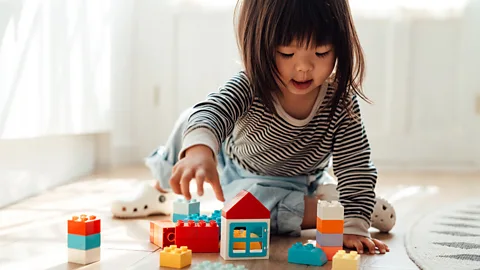Why parents shouldn't always be 'in sync' with their children
 Getty Images
Getty ImagesParents are often advised to be constantly attuned to their children and to respond to their every need. But is this always the right approach?
It's crucial for healthy child development that children can form secure attachment bonds with their parents. Decades of research identified one key ingredient for this process: the coordination of parents' and children's brains and behaviour during social interactions.
Humans connect with each other by synchronising in many ways. Called bio-behavioural synchrony, this involves imitation of gestures and the alignment of heartbeats and hormone secretion (like cortisol and oxytocin). Even brains can synchronise – with brain activity decreasing and increasing in the same areas at roughly the same time when we spend time with others.
My colleagues and I carried out research which showed that brain-to-brain synchrony between parent and child can be helpful for children's attachment, and tends to rise when a parent and child play, talk or solve problems together. Recently, however, we started wondering whether more synchrony is always better. Our recent study, published in Developmental Science, suggests it can sometimes be a sign of relationship difficulties.
A lot of current parenting advice recommends parents to be constantly "in sync" with their kids. It tells parents to be physically close and attuned to their children and to anticipate and immediately respond to their every need.
The advice is building upon attachment theory and research, which show that higher parental sensitivity and reflective functioning are beneficial for child development and secure attachment formation.
Yet, despite its good intentions, this advice misses several important details. For example, research revealed that for about 50-70% of the time, parents and children are not "in sync". During these times, they may be doing separate activities, such as a child exploring something on their own or a parent working. They rather engage in a constant "social dance" comprising being attuned to each other, failing to do so and repairing this disconnect.
 Getty Images
Getty ImagesAnd it's this flow of connection, disconnection and reconnection that offers children an ideal mixture of parental support and moderate, useful stress that helps growing children's social brains.
Researchers also agree that there can be negative consequences to parents and children constantly being tuned in to each other. For example, it can increase stress on the relationship and raise the risk for insecure child attachment. That is especially true if it is associated with parents overstimulating their child or being too responsive to their child's every need.
For parent-child synchrony, there thus appears to be an "optimal midrange". Or, in other words, more synchrony may not necessarily be better.
Brain-to-brain synchrony and attachment
Within a large international team of investigators from across Europe, my colleagues Trinh Nguyen, Melanie Kungl, Stefanie Hoehl, Lars White and I set out to investigate how exactly parent-child bio-behavioural synchrony is linked to attachment.
We invited parent-child pairs – 140 parents and their 5-to-6-year-old kids – to the Social Neuroscience of Human Attachment Lab where they solved Chinese tangram puzzles together.
We measured brain activity with functional near-infrared spectroscopy "hyperscanning", for which parents and children were asked to wear caps linked up with optical sensors. We also recorded videos of their interactions so we could assess how much behavioural synchrony they demonstrated – how attuned and attentive they were to each other. And finally, we assessed parents' and children's type of attachment – known as attachment representations.
More like this:
We previously discovered increased neural synchrony in mother-child and father-child pairs during different tasks. In mother-child pairs, neural synchrony was linked to taking turns in solving puzzles or conversations. And in father-child pairs, synchrony during puzzling was linked to dads being confident about and enjoying their role as fathers. But does that mean higher parent-child neural synchrony is always a measure of a good relationship?
In our new study, we actually observed that mothers who had an insecure, anxious or avoidant attachment type showed more neural synchrony with their children. Interestingly, mothers' attachment types were unrelated to how synced mothers and children were in terms of their behaviour. We also found increased neural but decreased behavioural synchrony in father-child pairs (compared to mother-child pairs) independent of attachment.
Our findings suggest that higher neural synchrony may be the result of putting increased cognitive effort into the parent-child interaction. If mothers' attachment representations are insecure, it may be more difficult for mums and kids to coordinate and help each other during activities such as puzzle solving.
A similar explanation may apply to neural synchrony during father-child problem-solving. Dads are more familiar with active, rough-and-tumble play. Engaging in structured and cognitively demanding activities such as puzzles may therefore be more challenging and require more neural synchrony for father-child pairs.
Lessons to be learned
What do our new findings mean? Most importantly, parents should not feel that they must be "in sync" with their kids all the time and at all costs. High parent-child attunement can also reflect interaction difficulties and can often add up to parental burnout, further negatively impacting the parent-child relationship.
 Getty Images
Getty ImagesIt is of course helpful if parents are emotionally available, skilled in reading their children's cues and promptly and sensitively respond to their needs. Especially when children are young. However, it suffices for parents to be "good enough" – to be available when children need them rather than "always on".
Children can also benefit from freedom and independence emotionally, socially and cognitively, especially as they get older.
What really counts is that the parent-child relationship functions well overall. That children can develop trust in their parents and that any mismatches, which naturally occur all the time, are successfully repaired. That's the true essence of attachment theory, which is often missed and misrepresented in parenting advice.
--
This article originally appeared on The Conversation, and is republished under a Creative Commons licence.
For essential climate news and hopeful developments to your inbox, sign up to the Future Earth newsletter, while The Essential List delivers a handpicked selection of features and insights.
